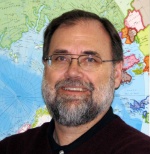 The Bering Strait is usually thought of as the migratory path whereby many of our ancestors found their way to America.
The Bering Strait is usually thought of as the migratory path whereby many of our ancestors found their way to America.
Dennis O’Rourke, professor of anthropology at the University of Utah, is hunting for clues that might indicate a people indigenous to this area.
Dr. Dennis O’Rourke is a professor in the Department of Anthropology at the University of Utah. His areas of interest include: population and evolutionary genetics, ancient DNA analysis, quantitative methods, native America, Arctic regions and Siberia. Current work involves the Ancient DNA Research Projects and Lab. He earned a PhD from the University of Kansas in 1980.
Dennis O’Rourke – Life on the Bering Land Bridge
During the Last Glacial Maximum thick ice sheets in Europe and North America dropped sea levels some 400 feet, exposing a broad undersea shelf connecting Siberia and Alaska. Known as The Bering Land Bridge, it measured over 1,000 miles north to south and 3,000 miles east to west.
Genetic evidence indicates the ancestors of Native Americans lived in the region for 10,000 years until they began moving south about 15,000 years ago. But the presence of a resident Beringian population has been questioned since there is little archaeological evidence to support it. My colleagues, John Hoffecker, Scott Elias, and I seek to reconcile existing genetic evidence for human habitation on this land bridge with paleoecological data and an absence of archaeological evidence.
Unlike much of northern North America, Beringia lacked lowland glaciers, and the Land Bridge at its center experienced summer temperatures little different from today. Sediment cores drilled from the Bering Sea floor contain plant and insect fossils indicating the Land Bridge was dotted by “refugia” of dwarf shrubs and possibly even trees. Wood resources would have been critical for survival and subsistence on the land bridge.
A distinct Native American genome had emerged by 25,000 years ago. A key element in its development was extended isolation from its Asian source population. The shrub-tundra refugia on the lowland land bridge provided perhaps the only geographic area at high latitudes where a population could survive the last glacial maximum in total isolation. Populations inhabiting these refugia would be nearly invisible archaeologically, since the refugia are now submerged under the Bering and Chukchi Seas. Evidence of human habitation in Pleistocene shrub tundra might still remain in low-lying portions of Alaska and eastern Siberia.
Read More: American ancestors lived for 10,000 years on the Bering land bridge

Comments
One response to “Dennis O’Rourke, University of Utah – Life on the Bering Land Bridge”